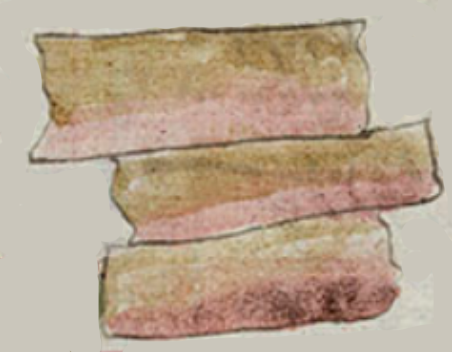huapalli (CST32)
This painting of the simplex glyph for the term huapalli (planks) shows three short, wide planks. Each board is about half brown and half pink. The ends are not cut straight, but appear to be natural. The wood was apparently to be acquired from the altepetl of Ocotepec. The next page speaks of adzes (using the loanword from Spanish, azuelas) for shaving wood (using the verb cuauhxima); perhaps they would be used for working on these planks.
Stephanie Wood
For more on the Codex Sierra, see Kevin Terraciano’s study (2021).
Stephanie Wood
1550–1564
Jeff Haskett-Wood
madera, tablas, vigas, construcción

huapal(li), plank, board, or small beam, https://nahuatl.wired-humanities.org/content/huapalli
tablones
Stephanie Wood
Códice Sierra-Texupan, plate 32, page dated 1560. Origin: Santa Catalina Texupan, Mixteca Alta, State of Oaxaca. Kevin Terraciano has published an outstanding study of this manuscript (Codex Sierra, 2021), and in his book he refers to alphabetic and “pictorial” writing, not hieroglyphic writing. We are still counting some of the imagery from this source as hieroglyphic writing, but we are also including examples of “iconography” where the images verge on European style illustrations or scenes showing activities. We have this iconography category so that such images can be fruitfully compared with hieroglyphs. Hieroglyphic writing was evolving as a result of the influence of European illustrations, and even alphabetic writing impacted it.
https://bidilaf.buap.mx/objeto.xql?id=48281&busqueda=Texupan&action=search
The Biblioteca Digital Lafragua of the Biblioteca Histórica José María Lafragua in Puebla, Mexico, publishes this Códice Sierra-Texupan, 1550–1564 (62pp., 30.7 x 21.8 cm.), referring to it as being in the “Public Domain.” This image is published here under a Creative Commons license, asking that you cite the Biblioteca Digital Lafragua and this Visual Lexicon of Aztec Hieroglyphs.






